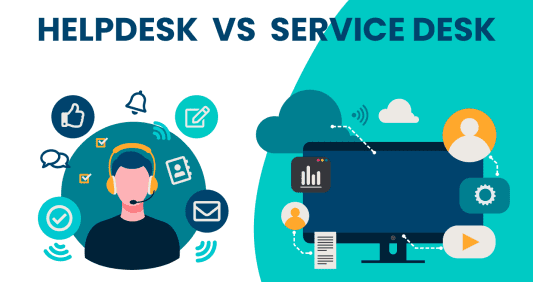Understanding The Key Differences: Helpdesk Vs Service Desk

Choosing between a helpdesk and a service desk can feel confusing. You might be looking for IT support but aren’t sure which option fits your needs. Many business owners face this same challenge, so you’re not alone.
Here’s a fact: while both offer IT assistance, their focus and functions differ significantly. Understanding these differences can save time, improve operations, and prevent headaches.
In this blog, you’ll learn how helpdesks focus on quick fixes while service desks address broader solutions. This guide will clarify the comparison between helpdesk vs service desk, making it easier to select the ideal solution.
Keep reading to make a well-informed choice!
What Is a Help Desk?
A help desk serves as the initial point of contact for technical issues. It addresses IT problems promptly, reducing downtime for users. Manned by technicians, it manages requests such as password resets, software errors, or device setups.
Created to simplify support processes, a help desk often uses ticketing systems to arrange and monitor user concerns. It concentrates on resolving specific issues rather than larger business strategies. For businesses in need of funding to set up or enhance their help desk operations, Credibly’s loans in Tempe can offer valuable support.
What Is a Service Desk?
A service desk functions as the central point for IT-related requests and support. It links users with technical teams, addressing issues efficiently while offering a wider range of services than a help desk.
In addition to resolving problems, it oversees tasks such as ticketing, updates, and resource distribution. Its objective is to improve operations across an organization.
This tool goes beyond addressing immediate challenges; it aligns IT activities with business goals. Service desks often incorporate processes like change management or asset tracking to minimize downtime and enhance productivity.
Key Differences Between Help Desk and Service Desk
Understanding their contrasts can help you pick the right one for your business needs.
Focus and Scope
Help desks primarily focus on resolving immediate technical issues for end-users. Their scope revolves around troubleshooting, fixing bugs, and addressing user queries promptly. These services are aimed at providing responsive support to daily problems.
Service desks, on the other hand, have a wider focus. They manage IT service operations comprehensively and align with business objectives. Beyond solving issues, they address long-term enhancements and ensure efficient operations across various functions.
Proactive vs. Reactive Approach
A help desk often takes an immediate approach. It focuses on resolving issues as they arise, like fixing a leak after the water starts dripping. Service desks aim to be more forward-looking, addressing potential IT challenges before they grow.
For example, a service desk might monitor systems to prevent server downtime instead of waiting for it to crash. This additional level of planning helps businesses maintain smooth and efficient operations.
Types of Services Offered
Help desks and service desks offer different sets of services customized to user needs. Business owners must know these differences to make informed choices.
- Incident management focuses on resolving user-reported problems quickly. It supports businesses by addressing disruptions like software crashes or printer issues.
- Knowledge management develops a database of solutions for users’ common questions. This improves efficiency while reducing repeated requests.
- Ticketing systems track, manage, and prioritize issues reported by employees or customers.
- Change management organizes improvements in technology or processes for better operations.
- Asset management keeps track of tools, hardware, and licenses within the company for proper usage.
- Remote support helps users off-site using phone calls, chats, or remote-access tools to solve IT problems.
- Request fulfillment addresses additional needs such as password resets or new user setup within an organization.
Benefits of Help Desks
Help desks address issues promptly, ensuring business operations remain efficient. They also foster a closer relationship between users and IT teams.
Quick Issue Resolution
Help desks quickly resolve user problems. Consider them the initial responders to technical issues, whether it’s locked accounts or malfunctioning software. Efficiency is their strength, often resolving issues in minutes rather than hours.
Businesses rely on continuous operations, and fast resolutions save both time and money. Picture an employee dealing with a frozen system; every moment matters. Help desks act promptly to reduce downtime and ensure operations continue without interruption.
Enhanced End-User Support
Providing fast issue resolution lays the groundwork for better end-user support. A help desk focuses on resolving user frustrations, leaving employees or clients more productive and less stressed.
Resolving minor issues quickly reduces downtime and improves workplace efficiency.
Service desks actively improve overall satisfaction by addressing recurring problems through broader IT solutions. They assist in simplifying processes, keeping users informed, and ensuring smooth communication.
This approach minimizes confusion while helping businesses maintain professional relationships with customers or teams.
Benefits of Service Desks
Service desks enhance IT support comprehensively by addressing broader aspects. They not only solve issues but also focus on prevention.
Holistic IT Service Management
Effective IT service management addresses every stage of IT operations. It brings together technology, people, and processes to support business goals. This approach combines multiple services like incident management, asset tracking, and change control into one framework.
Small gaps can cause system failures or delays for end-users. A unified process reduces downtime and improves satisfaction across departments. For managed IT services providers, this solution enhances communication between teams while ensuring efficient workflows at all times.
Strategic Problem Solving
Service desks focus on identifying root causes, not just fixing symptoms. Teams analyze recurring IT issues and create long-term solutions to prevent them. This approach reduces downtime and enhances system reliability over time.
Staff may also work with different departments to align IT goals with business needs. For example, addressing gaps in software compatibility can improve workflow efficiency for employees.
This level of planning simplifies daily operations across the organization.
Choosing Between a Help Desk and a Service Desk
Decide based on your business needs. A help desk focuses on solving immediate technical issues, like password resets or software problems. It suits companies seeking quick fixes for IT troubles.
A service desk supports broader IT goals by managing services like onboarding, change requests, and complex systems. It’s ideal for businesses prioritizing long-term IT strategies and organization-wide solutions.
Conclusion
Choosing between a helpdesk and a service desk depends on your business needs. Both have advantages, but they address different challenges. Recognizing their purpose can save time and frustration.
Consider what fits best with your objectives. A clear decision helps enhance support efficiently.






